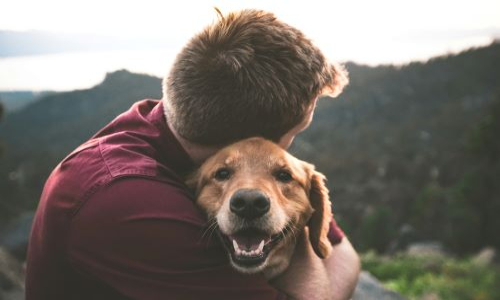The Ripple Effect: How Assistance Dogs Impact Families and Communities
The Immediate Circle: Families of Veterans
Strengthening Family Bonds
Assistance dogs play a crucial role in alleviating stress within family dynamics and mitigating the impacts of social isolation. Their presence can ease tensions, promote positive interactions, and provide a shared focus for families. Real-life stories abound of households drawn closer together, with the assistant dog, a furry companion, at the heart of this newfound harmony, enhancing the interactions and sense of community. For instance, a family reported significant improvements in communication and understanding amongst members, attributing these changes to the calming influence of their assistance dog. In another case, a child with special needs found comfort and support in their assistance dog, which facilitated a stronger bond between the child and their siblings. The dog served as a bridge between family members and provided a sense of companionship and security.
Assistance dogs can help reduce stress and anxiety levels in both children and adults within the family. By providing emotional support and a constant source of comfort, these dogs can help create a more peaceful and relaxed environment, embodying the concept of a furry companion delivering deep emotional connections. This can lead to improved overall well-being, enhanced relationships amongst family members, and expanded social networks, suggesting pets have a ripple effect on one's social life.
The presence of an assistance dog can have a transformative impact on family dynamics. By promoting communication, reducing stress, and fostering closer connections, these dogs play a vital role in creating a positive and supportive family environment, serving as companion animals that significantly improve social interaction within families. Their unconditional love and unwavering support can bring families closer together, contribute to a happier and healthier household, and strengthen the social network of dog owners.
Educating Children on Empathy and Responsibility
Children, in particular, benefit from the presence of an assistance dog in the home. Through daily interactions, they learn valuable lessons in empathy, compassion, and responsibility, highlighting the role of pet ownership in fostering social values within the community. These dogs also serve as gentle educators on the topics of disabilities and mental health, helping children understand and respect differences from a young age, thus fostering a broader community of inclusivity. Furthermore, assistance dogs can provide a sense of security and comfort to children who may be experiencing physical or emotional challenges. These dogs are trained to respond to specific needs and can provide support in a variety of ways, such as helping with tasks, providing emotional support, and even alerting others in case of an emergency.
Having an assistance dog in the home can also help children develop a sense of routine and discipline, as they are responsible for caring for the dog and following a schedule of feeding, grooming, and training. This can help instil important life skills and values in children, such as patience, consistency, and the ability to work as a team, reflecting the social and emotional benefits of dog ownership.
An assistance dog can have a positive impact on a child's development and well-being, providing them with a loyal friend and companion who can offer unconditional love and support, thus reducing social isolation. By interacting with and caring for an assistance dog, children can learn important life lessons and develop empathy and compassion towards others, making them more well-rounded individuals in the process.
Beyond the Home: Impact on Local Communities
Fostering Community Inclusivity
Assistance dogs act as bridges, connecting veterans with their local communities and illustrating the profound impact of companion animals on neighbourhood interactions. By accompanying their handlers in public spaces, these dogs help break down social barriers and challenge misconceptions about mental health and disability, thereby reducing social isolation. Their presence encourages conversations and fosters a more inclusive environment for everyone. In addition to serving as companions and support for their handlers, assistance dogs, including facility dogs, can also provide a sense of security and comfort in social situations, enhancing social and emotional development. By being trained to sense the emotions and needs of their handlers, these dogs can help their owners navigate challenging or overwhelming situations in public settings, thus combatting social isolation.
These dogs also play a crucial role in helping veterans reintegrate into civilian life after their service, acting as a catalyst for social connections within the family and the local community. By providing a sense of normalcy and routine, as well as practical assistance with tasks such as retrieving items or navigating crowded spaces, assistance dogs can help veterans feel more confident and independent in their daily lives.
Assistance dogs can help veterans build connections with their local communities by facilitating interactions with strangers and breaking down social barriers, showcasing the role of companion animals in enhancing social interaction. By accompanying their handlers to various events and activities, these dogs can help veterans feel more at ease in new or unfamiliar environments and encourage positive interactions with others, reducing loneliness in the time of transition to civilian life.
Assistance dogs serve as important bridges that help veterans connect with their communities and overcome the challenges of mental health and disability, highlighting the critical role of companion animals in fostering community engagement. Through their support, these dogs not only improve the lives of their handlers but also help create a more inclusive and understanding society for all.
Inspiring Volunteerism and Support
The positive impact of assistance dogs often inspires community members to take action. Many are moved to volunteer their time or donate to assistance dog programs after witnessing the profound difference these animals make. Communities have rallied to raise funds for training more dogs, demonstrating the widespread support for this cause, and highlighting the ripple effect of companion animals in fostering neighbourhood interactions and sense. In addition, assistance dogs often serve as ambassadors for their organisations, attending community events, schools, and healthcare facilities to raise awareness about the benefits of service animals. By interacting with these dogs, community members of all ages are able to see first-hand the impact they have on individuals with disabilities, leading to increased acceptance and understanding.
The presence of assistance dogs in the community can also help break down societal barriers for individuals with disabilities, reflecting the broader social impact of companion animals on neighbourhood interactions and social inclusivity. By seeing a person with an assistance dog out in public, others are reminded of the capabilities and contributions of people with disabilities, leading to more inclusive attitudes and behaviours and exemplifying the broader community benefits of human-animal interaction.
The positive impact of assistance dogs goes far beyond the individual handler they serve, contributing to a wider social ripple effect of companion animals. They have the power to inspire communities to come together in support of a common cause, promote greater understanding and acceptance of individuals with disabilities, and help create a more inclusive and compassionate society for all.
The Educational Ripple: Schools and Workplaces
Assistance Dogs as Educational Tools
In educational settings and workplaces, assistance dogs serve as powerful tools for raising awareness about mental health and disability. Demonstrations and talks can significantly influence attitudes, promoting a culture of acceptance and understanding, and highlight the importance of the consortium on social isolation. These interactions help to create safer, more supportive environments for everyone, reflecting the beneficial effects of pets on the broader community and individual well-being. Furthermore, assistance dogs also play a crucial role in supporting individuals with mental health or physical disabilities, embodying the strong association between pet ownership and improved well-being. They offer companionship, emotional support, and practical assistance with daily tasks, enabling their handlers to live more independent and fulfilling lives. Assistance dogs can provide a sense of security and comfort, helping to reduce anxiety and improve mood.
In educational settings, assistance dogs can accompany students with disabilities, providing them with the support they need to fully participate in school activities. These dogs can help students navigate the campus, retrieve items, and provide emotional support during stressful situations. In workplaces, assistance dogs can assist employees with disabilities in performing their job tasks, promoting inclusion, equal opportunities, and highlighting the importance of ownership of dogs and cats in enriching human lives.
Assistance dogs play a vital role in promoting awareness, understanding, and support for individuals with disabilities, which underscores the association between pet ownership and societal inclusivity. Their presence can help to break down barriers and stigma, fostering a more inclusive and compassionate society that acknowledges the positive effects of dog ownership. By recognising and valuing the important role of assistance dogs, we can create a positive impact on the lives of individuals with disabilities and contribute to a more diverse and inclusive community.
The Wider Societal Impact
Changing Perceptions on Mental Health and Disability
The visibility of assistance dogs in the media and public life plays a vital role in normalising mental health challenges and disability. Stories of their impact can shift public perceptions, leading to greater empathy and understanding across society. When assistance dogs are featured in the media, whether through news coverage, documentaries, or social media posts, it helps to bring awareness to the important work they do and the positive impact they have on individuals living with disabilities or mental health challenges. By showcasing the daily routines and tasks that these dogs help their owners with, such as guiding the visually impaired, alerting to seizures, or providing emotional support, the public gains a better understanding of the incredible bond between assistance dogs and their handlers.
These stories also highlight the benefits that assistance dogs bring to their owners, including increased independence, improved mental well-being, and a sense of companionship and connection, underscoring the positive effects of pet ownership. By seeing these positive outcomes, including enhanced human-animal interaction, people may become more accepting and supportive of dog owners who rely on assistance dogs for their everyday needs.
Moreover, the visibility of assistance dogs in public life, such as in schools, workplaces, and other community settings, can help to break down stereotypes and stigma surrounding disabilities and mental health conditions. When members of the public interact with these dogs and their handlers in various settings, they may learn to appreciate the unique abilities and contributions of individuals with disabilities, and to be more inclusive and accommodating in their attitudes and behaviours.
The presence of assistance dogs in the media and public life serves as a powerful tool for promoting awareness, understanding, and acceptance of mental health challenges and disability. By sharing their stories and showcasing their impact, these amazing animals and their handlers can inspire compassion, empathy, and positive change in society as a whole.
Encouraging Policy and Accessibility Changes
The increasing presence of assistance dogs has spurred changes in policies related to animal access and rights, showcasing the pets' role as a catalyst for social and legislative changes within the broader community. Their needs have highlighted the importance of accessibility in public spaces, leading to improvements that benefit a broader segment of the population. For example, businesses and public buildings have started to implement more accommodating policies for individuals with assistance animals, showing the positive effect of pet ownership. This includes allowing them to accompany their owners in more places, such as restaurants, hotels, and even public transportation, enhancing the social interaction between pet owners and non-pet owners. These changes not only benefit those with assistance animals but also promote inclusivity and diversity in public spaces, reflecting the positive influence of pet ownership on community dynamics.
Additionally, the presence of assistance dogs has raised awareness about the rights and responsibilities of individuals with disabilities. Many people are now more informed about the laws that protect individuals with assistance animals, such as the Equality Act (2010), which guarantees equal access to public places for individuals with disabilities and their assistance dogs.
Overall, the increased presence of assistance dogs has sparked positive changes in policies and attitudes towards animal access and rights. These changes have created a more inclusive and accommodating environment for individuals with disabilities and their assistance animals, ultimately benefiting society as a whole.
The ripple effect of assistance dogs on families, communities, and society is profound, illustrating how pets have a ripple effect that extends beyond the immediate family to influence the local community and beyond. These animals do more than assist veterans with mental health challenges; they foster connections, understanding, and inclusivity.
By supporting assistance dog programmes, we contribute to a more empathetic and compassionate world. These dogs not only provide both physical and psychological assistance to their handlers, but they also offer emotional support and companionship. They can help reduce feelings of isolation and loneliness, improve mental health, and increase overall quality of life for individuals with disabilities, underscoring the importance of companion animals in community-building and social support networks.
Assistance dogs also have a ripple effect on families, as they often become beloved members of the household, demonstrating the profound impact owned dogs or cats can have on family dynamics. They can help strengthen bonds between family members, facilitate communication and interaction, and provide a sense of security and safety for everyone in the home.
In addition, assistance dogs play a role in building more inclusive communities. Their presence in public spaces can help raise awareness and educate the public about the rights and needs of individuals with disabilities. They can also serve as ambassadors for their handlers, breaking down barriers and promoting acceptance and understanding of diversity.
On a larger scale, supporting assistance dog programmes contributes to a more compassionate society. By investing in the training and care of these incredible animals, we are investing in the well-being and happiness of individuals and families in need. We are also promoting a culture of empathy and kindness, where everyone is valued and included, which is a key goal of the consortium on social isolation, emphasising how pets have a ripple effect on reducing loneliness in the time of increased isolation.
Assistance dogs have a far-reaching impact that extends beyond their immediate roles as helpers and companions. They have the power to transform lives, strengthen relationships, and build more compassionate and inclusive communities. By supporting assistance dog programmes, we are helping to create a better world for all.








